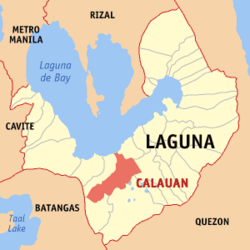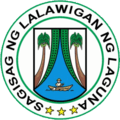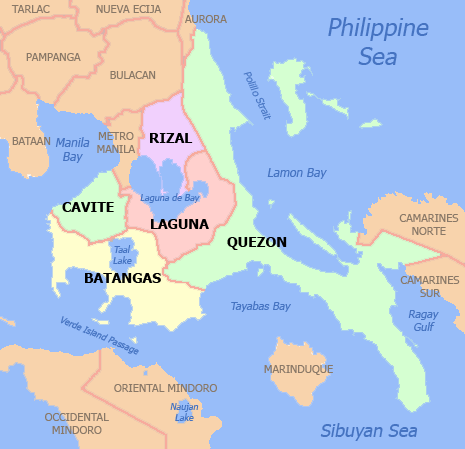Calauan, Laguna
| Calauan | ||
|---|---|---|
| Municipality | ||
| Municipality of Calauan | ||
|
Welcome Arch | ||
| ||
| Nickname(s): Home of the Sweet Laguna Pineapple[1] | ||
 Map of Laguna with Calauan highlighted | ||
.svg.png) Calauan Location within the Philippines | ||
| Coordinates: 14°09′N 121°19′E / 14.15°N 121.32°ECoordinates: 14°09′N 121°19′E / 14.15°N 121.32°E | ||
| Country |
| |
| Region | Calabarzon (Region IV-A) | |
| Province | Laguna | |
| District | 3rd District | |
| Barangays | 15 (see Barangays) | |
| Government [2] | ||
| • Type | Sangguniang Bayan | |
| • Mayor | Buenafrido T. Berris | |
| • Electorate | 34,676 voters (2016) | |
| Area [3] | ||
| • Total | 65.40 km2 (25.25 sq mi) | |
| Population (2015 census)[4] | ||
| • Total | 80,453 | |
| • Density | 1,200/km2 (3,200/sq mi) | |
| Time zone | UTC+8 (PST) | |
| ZIP code | 4012 | |
| PSGC | 043406000 | |
| IDD : area code | +63 (0)49 | |
| Climate type | Tropical monsoon climate | |
| Income class | 2nd municipal income class | |
| Revenue (₱) | 159,831,202.61 (2016) | |
| Native languages | Tagalog | |
| Website |
www | |
Calauan, officially the Municipality of Calauan, (Tagalog: Bayan ng Calauan), is a 2nd class municipality in the province of Laguna, Philippines. According to the 2015 census, it has a population of 80,453 people.[4]
The town got its name from the term kalawang, which means rust. Folklore has it that the town got its name when the Spanish started construction of the Municipal Church and water seeped in from the holes dug into the ground for the Church's foundation. The water was colored brown and rusty in character hence the name Calauan (Kalawang). Calauan is known for the Pineapple Festival, which is celebrated every 15 May.
The patron saint of Calauan is Isidore the Laborer, the patron of farmers, known in Spanish as San Isidro Labrador.
Calauan's population is expected rise as the town is being used as resettlement of informal settlers in Metro Manila through the Bayan ni Juan and the Kapit-Bisig para sa Ilog Pasig project of the ABS-CBN Foundation.
Popular destinations in the area include the Field of Faith situated in Brgy. Lamot 2 and the Isdaan Floating Restaurant located along the National Highway going to Victoria Laguna.
History
The fertile soil of Calauan attracted attention of Captain Juan de Salcedo, when he passed through Laguna and Tayabas (now Quezon) on his way to Bicol Region in 1570. Ten years later, Spanish authorities established a town government two kilometers from the site of the present Poblacion, in what is now Barrio Mabacan. They called the townsite “Calauan” (Tagalog word for rust). Following in epidemic in 1703, the town was moved to its present site at the fork of three roads---now to the south-west leading to San Pablo City, the other southeastward to Sta. Cruz, the provincial capital, and the third going North to Manila.
At the turn of the 18th century, when Bay was designated as the provincial capital of Laguna, Calauan became a sitio of Bay. Merchants going to Southern Luzon passed through Bay and Calauan. One of them, an opulent Spaniard by the name of Iñigo, bought large tracts of land in Calauan in 1812. The landholdings of Iñigo and, later, of his heirs were so vast that many portions were still unsettled. The property was and still is, known as Hacienda Calauan. About a century later, the people of Calauan fought a “guardia civil” during the Philippine Revolution. Basilio Geiroza (better known as Cabesang Basilio) and his men routed a battalion of “guardia civiles” in a five-hour battle in Bario Cupangan (now Lamot I) in December 1897. During the subsequent Philippine-American hostilities, Calauan patriots fought numerically superior forces of General Otis in Barrio San Diego of San Pablo. With the establishment of civilian authority in Calauan in 1902, the Americans assigned Mariano Marfori as first “presidente”. Hacienda Calauan financed the construction of a hospital in 1926, and Mariano O. Marfori, Jr. son of the first municipal presidente, as hospital director and the resident physician, respectively.
In 1939, by the request of President Quezon, Doña Margarita Roxas vda. De Soriano, granddaughter of the Spaniard Inigo, subdivided Hacienda Calauan and sold it to the tenants, part of what remained was converted into a rest house and a swimming pool and it became one of the tourist attractions until 1956.
In 1993, the town became the focus of media attention when Antonio Sánchez, who was serving as mayor at the time, got involved into a double murder case involving two UPLB students. Sánchez and several other men were given a life sentence.
Barangays
Demographics
| Population census of Calauan | ||
|---|---|---|
| Year | Pop. | ±% p.a. |
| 1903 | 2,624 | — |
| 1918 | 2,832 | +0.51% |
| 1939 | 7,302 | +4.61% |
| 1948 | 9,180 | +2.58% |
| 1960 | 13,168 | +3.05% |
| 1970 | 19,747 | +4.13% |
| 1975 | 23,370 | +3.44% |
| 1980 | 25,259 | +1.57% |
| 1990 | 32,736 | +2.63% |
| 1995 | 36,677 | +2.15% |
| 2000 | 43,284 | +3.61% |
| 2007 | 54,248 | +3.16% |
| 2010 | 74,890 | +12.45% |
| 2015 | 80,453 | +1.37% |
| Source: Philippine Statistics Authority[4] [5] [6] [7] | ||
In the 2015 census, the population of Calauan, Laguna, was 80,453 people,[4] with a density of 1,200 inhabitants per square kilometre or 3,100 inhabitants per square mile.
Local government
Municipal officials (2013-2016):
Municipal Councilors:
References
- ↑ "Calauan official website". Calauanlaguna.gov.ph. Retrieved 2012-07-31.
- ↑ "Municipality". Quezon City, Philippines: Department of the Interior and Local Government. Retrieved 31 May 2013.
- 1 2 "Province: Laguna". PSGC Interactive. Quezon City, Philippines: Philippine Statistics Authority. Retrieved 12 November 2016.
- 1 2 3 4 Census of Population (2015). "Region IV-A (Calabarzon)". Total Population by Province, City, Municipality and Barangay. PSA. Retrieved 20 June 2016.
- ↑ Census of Population and Housing (2010). "Region IV-A (Calabarzon)". Total Population by Province, City, Municipality and Barangay. NSO. Retrieved 29 June 2016.
- ↑ Censuses of Population (1903–2007). "Region IV-A (Calabarzon)". Table 1. Population Enumerated in Various Censuses by Province/Highly Urbanized City: 1903 to 2007. NSO.
- ↑ "Province of Laguna". Municipality Population Data. Local Water Utilities Administration Research Division. Retrieved 17 December 2016.
External links
| Wikimedia Commons has media related to Calauan, Laguna. |


